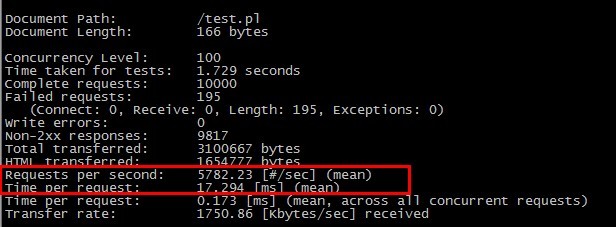nginx + fastcgi是php下最流行的一套环境了,那perl会不会也有fastcgi呢,当然有,今天来搭建下nginx下perl的fastcgi.性能方面也不亚于php,但是现在web程序php的流行程度perl无法比拟了,性能再好也枉然,但是部分小功能可以考虑使用perl的fastcgi来搞定.进入正题.
1. 准备软件环境:
nginx:http://www.nginx.org
perl:系统自带
fastcgi:http://www.cpan.org/modules/by-module/FCGI/文章源自运维生存时间-https://www.ttlsa.com/nginx/perl-fastcgi-nginx/
1.1 nginx安装
nginx安装过无数次,这边不在重复安装过程,如果你还没有安装nginx并且不知道怎么安装nginx,那么请先参考之前的文章《nginx安装配置》文章源自运维生存时间-https://www.ttlsa.com/nginx/perl-fastcgi-nginx/
1.2 perl安装
一般linux都有自带perl,可以不用安装,如果确实没有,请执行:文章源自运维生存时间-https://www.ttlsa.com/nginx/perl-fastcgi-nginx/
# yum install perl
1.3 perl-fastcgi安装文章源自运维生存时间-https://www.ttlsa.com/nginx/perl-fastcgi-nginx/
# cd /usr/local/src # wget http://www.cpan.org/modules/by-module/FCGI/FCGI-0.74.tar.gz # tar -xzvf FCGI-0.74.tar.gz # cd FCGI-0.74 # perl Makefile.PL # make # make install
2. nginx虚拟主机配置
server {
listen 80;
server_name test.ttlsa.com;
#access_log /data/logs/nginx/test.ttlsa.com.access.log main;
index index.html index.php index.html;
root /data/site/test.ttlsa.com;
location /
{
}
location ~ \.pl$
{
include fastcgi_params;
fastcgi_pass 127.0.0.1:8999;
#fastcgi_pass unix:/var/run/ttlsa.com.perl.sock;
fastcgi_index index.pl;
}
}
如果想把tcp/ip方式改为socket方式,可以修改fastcgi-wrapper.pl.文章源自运维生存时间-https://www.ttlsa.com/nginx/perl-fastcgi-nginx/
$socket = FCGI::OpenSocket( "127.0.0.1:8999", 10 ); #use IP sockets 改为 $socket = FCGI::OpenSocket( "/var/run/ttlsa.com.perl.sock", 10 ); #use IP sockets
3. 配置脚本
3.1 fastcgi监听脚本
文件路径:/usr/bin/fastcgi-wrapper.pl文章源自运维生存时间-https://www.ttlsa.com/nginx/perl-fastcgi-nginx/
#!/usr/bin/perl
use FCGI;
use Socket;
use POSIX qw(setsid);
require 'syscall.ph';
&daemonize;
#this keeps the program alive or something after exec'ing perl scripts
END() { } BEGIN() { }
*CORE::GLOBAL::exit = sub { die "fakeexit\nrc=".shift()."\n"; };
eval q{exit};
if ($@) {
exit unless $@ =~ /^fakeexit/;
};
&main;
sub daemonize() {
chdir '/' or die "Can't chdir to /: $!";
defined(my $pid = fork) or die "Can't fork: $!";
exit if $pid;
setsid or die "Can't start a new session: $!";
umask 0;
}
sub main {
$socket = FCGI::OpenSocket( "127.0.0.1:8999", 10 ); #use IP sockets
$request = FCGI::Request( \*STDIN, \*STDOUT, \*STDERR, \%req_params, $socket );
if ($request) { request_loop()};
FCGI::CloseSocket( $socket );
}
sub request_loop {
while( $request->Accept() >= 0 ) {
#processing any STDIN input from WebServer (for CGI-POST actions)
$stdin_passthrough ='';
$req_len = 0 + $req_params{'CONTENT_LENGTH'};
if (($req_params{'REQUEST_METHOD'} eq 'POST') && ($req_len != 0) ){
my $bytes_read = 0;
while ($bytes_read < $req_len) {
my $data = '';
my $bytes = read(STDIN, $data, ($req_len - $bytes_read));
last if ($bytes == 0 || !defined($bytes));
$stdin_passthrough .= $data;
$bytes_read += $bytes;
}
}
#running the cgi app
if ( (-x $req_params{SCRIPT_FILENAME}) && #can I execute this?
(-s $req_params{SCRIPT_FILENAME}) && #Is this file empty?
(-r $req_params{SCRIPT_FILENAME}) #can I read this file?
){
pipe(CHILD_RD, PARENT_WR);
my $pid = open(KID_TO_READ, "-|");
unless(defined($pid)) {
print("Content-type: text/plain\r\n\r\n");
print "Error: CGI app returned no output - ";
print "Executing $req_params{SCRIPT_FILENAME} failed !\n";
next;
}
if ($pid > 0) {
close(CHILD_RD);
print PARENT_WR $stdin_passthrough;
close(PARENT_WR);
while(my $s = <KID_TO_READ>) { print $s; }
close KID_TO_READ;
waitpid($pid, 0);
} else {
foreach $key ( keys %req_params){
$ENV{$key} = $req_params{$key};
}
# cd to the script's local directory
if ($req_params{SCRIPT_FILENAME} =~ /^(.*)\/[^\/]+$/) {
chdir $1;
}
close(PARENT_WR);
close(STDIN);
#fcntl(CHILD_RD, F_DUPFD, 0);
syscall(&SYS_dup2, fileno(CHILD_RD), 0);
#open(STDIN, "<&CHILD_RD");
exec($req_params{SCRIPT_FILENAME});
die("exec failed");
}
}
else {
print("Content-type: text/plain\r\n\r\n");
print "Error: No such CGI app - $req_params{SCRIPT_FILENAME} may not ";
print "exist or is not executable by this process.\n";
}
}
}
3.2 fastcgi自启动服务脚本:文章源自运维生存时间-https://www.ttlsa.com/nginx/perl-fastcgi-nginx/
文件路径:/etc/rc.d/init.d/perl-fastcgi
#!/bin/sh
#
# nginx – this script starts and stops the nginx daemon
#
# chkconfig: - 85 15
# description: Nginx is an HTTP(S) server, HTTP(S) reverse \
# proxy and IMAP/POP3 proxy server
# processname: nginx
# config: /opt/nginx/conf/nginx.conf
# pidfile: /opt/nginx/logs/nginx.pid
# Source function library.
. /etc/rc.d/init.d/functions
# Source networking configuration.
. /etc/sysconfig/network
# Check that networking is up.
[ "$NETWORKING" = "no" ] && exit 0
perlfastcgi="/usr/bin/fastcgi-wrapper.pl"
prog=$(basename perl)
lockfile=/var/lock/subsys/perl-fastcgi
start() {
[ -x $perlfastcgi ] || exit 5
echo -n $"Starting $prog: "
daemon $perlfastcgi
retval=$?
echo
[ $retval -eq 0 ] && touch $lockfile
return $retval
}
stop() {
echo -n $"Stopping $prog: "
killproc $prog -QUIT
retval=$?
echo
[ $retval -eq 0 ] && rm -f $lockfile
return $retval
}
restart() {
stop
start
}
reload() {
echo -n $”Reloading $prog: ”
killproc $nginx -HUP
RETVAL=$?
echo
}
force_reload() {
restart
}
rh_status() {
status $prog
}
rh_status_q() {
rh_status >/dev/null 2>&1
}
case "$1" in
start)
rh_status_q && exit 0
$1
;;
stop)
rh_status_q || exit 0
$1
;;
restart)
$1
;;
reload)
rh_status_q || exit 7
$1
;;
force-reload)
force_reload
;;
status)
rh_status
;;
condrestart|try-restart)
rh_status_q || exit 0
;;
*)
echo $"Usage: $0 {start|stop|status|restart|condrestart|try-restart|reload|force-reload}"
exit 2
esac
3.3 设置脚本权限文章源自运维生存时间-https://www.ttlsa.com/nginx/perl-fastcgi-nginx/
# chmod a+x /usr/bin/fastcgi-wrapper.pl # chmod a+x /etc/rc.d/init.d/perl-fastcgi
4. FastCGI测试
4.1 启动nginx与fastcgi # /usr/local/nginx-1.4.2/sbin/nginx # /etc/init.d/perl-fastcgi start
4.2 perl测试文件:
文件路径/data/site/test.ttlsa.com/test.pl文章源自运维生存时间-https://www.ttlsa.com/nginx/perl-fastcgi-nginx/
#!/usr/bin/perl
print "Content-type:text/html\n\n";
print <<EndOfHTML;
<html><head><title>Perl Environment Variables</title></head>
<body>
<h1>Perl Environment Variables</h1>
EndOfHTML
foreach $key (sort(keys %ENV)) {
print "$key = $ENV{$key}<br>\n";
}
print "</body></html>";
5. 访问测试
5.1 访问文章源自运维生存时间-https://www.ttlsa.com/nginx/perl-fastcgi-nginx/
http://http:test.ttlsa.com/test.pl,出现内容表示OK.文章源自运维生存时间-https://www.ttlsa.com/nginx/perl-fastcgi-nginx/
文章源自运维生存时间-https://www.ttlsa.com/nginx/perl-fastcgi-nginx/
6. 简单压力测试:
6.1 使用tcp/ip方式文章源自运维生存时间-https://www.ttlsa.com/nginx/perl-fastcgi-nginx/
ab -n 1000 -c 10 http://test.ttlsa.com/test.pl
他是在是太慢了,只好用10个并发,共计100个请求来测试.文章源自运维生存时间-https://www.ttlsa.com/nginx/perl-fastcgi-nginx/

perl + fastcgi + tcp-ip
6.2 使用socket方式:文章源自运维生存时间-https://www.ttlsa.com/nginx/perl-fastcgi-nginx/
ab -n 100000 -c 500 http://test.ttlsa.com/test.pl

perl + fastcgi + socket
很奇怪,使用tcp/ip方式,每秒就140多个请求,而使用socket方式却有5800个请求/秒。差距不是一般的大。顺便测试了一下php的fastcgi,大概请求在3000(tcp/ip方式),4800(socket方式)。文章源自运维生存时间-https://www.ttlsa.com/nginx/perl-fastcgi-nginx/
7. 文件下载
perl脚本下载:perl-fastcgi,fastcgi-wrapper.pl,test.perl三个文件文章源自运维生存时间-https://www.ttlsa.com/nginx/perl-fastcgi-nginx/
文章源自运维生存时间-https://www.ttlsa.com/nginx/perl-fastcgi-nginx/
转载请注明出处: https://www.ttlsa.com/html/2411.html文章源自运维生存时间-https://www.ttlsa.com/nginx/perl-fastcgi-nginx/
文章源自运维生存时间-https://www.ttlsa.com/nginx/perl-fastcgi-nginx/


4F
php-fpm开启。。nginx如何去调用php-fpm来解释cgi文件,我现在把cgi文件交给php-fpm处理,页面就会出现cgi文件的源码
B1
@ Ryan 这边是Perl的fastcgi与php-fpm无关
3F
请问访问test.pl为什么:
504 Gateway Time-out
nginx/1.4.1 (Ubuntu)
B1
@ 微宇 加群
2F
请问perl + fastcgi + nginx这种搭配是否能使用perl 标准mysql模块如dbi dbd访问mysql?????
1F
研究研究
来自外部的引用